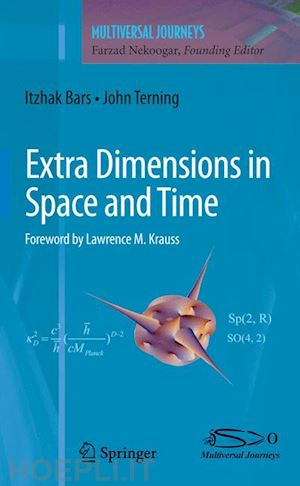
Questo prodotto usufruisce delle SPEDIZIONI GRATIS
selezionando l'opzione Corriere Veloce in fase di ordine.
Pagabile anche con Carta della cultura giovani e del merito, 18App Bonus Cultura e Carta del Docente
In physics, the idea of extra spatial dimensions originates from Nordstöm’s 5-dimensional vector theory in 1914, followed by Kaluza-Klein theory in 1921, in an effort to unify general relativity and electromagnetism in a 5 dimensional space-time (4 dimensions for space and 1 for time). Kaluza–Klein theory didn’t generate enough interest with physicist for the next five decades, due to its problems with inconsistencies. With the advent of supergravity theory (the theory that unifies general relativity and supersymmetry theories) in late 1970’s and eventually, string theories (1980s) and M-theory (1990s), the dimensions of space-time increased to 11 (10-space and 1-time dimension).
There are two main features in this book that differentiates it from other books written about extra dimensions: The first feature is the coverage of extra dimensions in time (Two Time physics), which has not been covered in earlier books about extra dimensions. All other books mainly cover extra spatial dimensions. The second feature deals with level of presentation. The material is presented in a non-technical language followed by additional sections (in the form of appendices or footnotes) that explain the basic equations and formulas in the theories. This feature is very attractive to readers who want to find out more about the theories involved beyond the basic description for a layperson. The text is designed for scientifically literate non-specialists who want to know the latest discoveries in theoretical physics in a non-technical language. Readers with basic undergraduate background in modern physics and quantum mechanics can easily understand the technical sections.
Part I starts with an overview of the Standard Model of particles and forces, notions of Einstein’s special and general relativity, and the overall view of the universe from the Big Bang to the present epoch, and covers Two-Time physics. 2T-physics has worked correctly at all scales ofphysics, both macroscopic and microscopic, for which there is experimental data so far. In addition to revealing hidden information even in familiar "everyday" physics, it also makes testable predictions in lesser known physics regimes that could be analyzed at the energy scales of the Large Hadron Collider at CERN or in cosmological observations."
Part II of the book is focused on extra dimensions of space. It covers the following topics: The Popular View of Extra Dimensions, Einstein and the Fourth Dimension, Traditional Extra Dimensions, Einstein's Gravity, The Theory Formerly Known as String, Warped Extra Dimensions, and How Do We Look For Extra Dimensions?
Professor John Terning - University of California, Davis
John Terning is Professor of Physics at University of California, Davis. He received his Ph.D. from University of Toronto and was a Postdoctoral Fellow at Yale University. He was also a researcher at Boston University, University of California, Berkeley and Harvard University. Professor Terning was a staff member at the Los Alamos National Laboratory. John Terning's research Interests include theoretical particle physics, electroweak symmetry breaking, supersymmetry, cosmology, extra dimensions, and AdS/CFT correspondence.
Professor Itzhak Bars, University of Southern California
Itzhak Bars is a Professor of Physics at the University of Southern California, Los Angeles. He received his Ph.D. from Yale University in 1971 and after postdoctoral research at the University of California at Berkeley he was appointed to the faculty of Stanford University in 1973. He returned to Yale University in 1975 as a faculty member
in the Physics Department, and after a decade he moved to the University of Southern California in 1984 to build a research group in High Energy Physics. He served as the director of the Caltech-USC Center for Theoretical Physics during 1999-2003. His visiting appointments include Harvard University, the Institute for Advanced Study in Princeton, and CERN in Geneva, Switzerland.
Professor Bars is a leading expert in symmetries in Physics, which he applies in much of his research on particle physics, field theory, string theory and mathematical physics in over 200 papers. He is the author of a book on "Quantum Mechanics" and co-editor of the books "Symmetry in Particle Physics" and "Strings '95, Future Perspectives in String Theory". Some of his experimentally successful physics predictions include supersymmetry in large nuclei with even/odd numbers of nucleons, and the weak interaction contribution to the anomalous magnetic moment of themuon, in the context of the quantized Standard Model, that was confirmed after 30 years. His contributions to the mathematics of supersymmetry are extensively used in several branches of physics and mathematics.
His current interests include String Field Theory, and Two-Time Physics which he originated in 1998. In 2006 he established that all the physics we know today, as embodied in principle in the Standard Model of Particles and Forces, is better described by a two-time field theory in 4 space and 2 time dimensions projected as a shadow on an emergent 3 space and 1 time dimensions. His honors include Fellow of the American Physical Society, the First Award in the Gravity Research Foundation essay contest (shared with Chris Pope), Outstanding Junior Investigator Award by the Department of Energy, and the A. P. Sloan Foundation Fellowship.











Il sito utilizza cookie ed altri strumenti di tracciamento che raccolgono informazioni dal dispositivo dell’utente. Oltre ai cookie tecnici ed analitici aggregati, strettamente necessari per il funzionamento di questo sito web, previo consenso dell’utente possono essere installati cookie di profilazione e marketing e cookie dei social media. Cliccando su “Accetto tutti i cookie” saranno attivate tutte le categorie di cookie. Per accettare solo deterninate categorie di cookie, cliccare invece su “Impostazioni cookie”. Chiudendo il banner o continuando a navigare saranno installati solo cookie tecnici. Per maggiori dettagli, consultare la Cookie Policy.